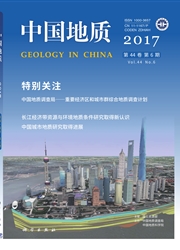

 中文摘要:
中文摘要:
粤西阳春盆地石菉铜钼矿床发育有氧化型铜及矽卡岩型铜钼矿体,矽卡岩型矿体在成因上与石菉花岗闪长岩相关。本文通过对辉钼矿化石英脉中的辉钼矿进行Re-Os同位素定年,结果显示,5件辉钼矿化石英脉获得较一致的模式年龄,介于(104±1.5)Ma-(104.6±1.5)Ma之间,加权平均值为(104.34±0.66)Ma,对应的等时线年龄为(104.1±1.3)Ma,略晚于成矿相关的花岗闪长岩的侵入年龄(107±0.72 Ma),表明成矿作用发生在早白垩世晚期。结合已有的研究成果认为,石菉矽卡岩型铜钼矿床形成滞后于阳春盆地内侏罗纪铜铁矿床近50 Ma,是华南白垩纪大规模成矿作用的一部分,其与区内侏罗纪铜铁矿床形成不同的构造背景,石菉铜钼矿床形成于岩石圈伸展拉张的背景。
 英文摘要:
英文摘要:
Located in Yangchun basin of western Guangdong Province,the Shilu deposit has developed oxidized Cu and skarn Cu-Mo ore bodies.The skarn ore body genetically is associated with the Shilu granodiorite.Direct Re-Os dating of molybdenite collected from the skarn ore bodies in the Shilu deposit was carried out to better understand the age of mineralization.The results show that the five molybdenite samples from quartz-vein-type ore have 187Re-187Os model ages ranging from(104±1.5) Ma to(104.6±1.5)Ma,with an average of(104.34±0.66)Ma and an isochron age of(104.1±1.3)Ma,consistent with the age of the related granodiorite(107±0.72Ma),which implies that the mineralization took place in the early Cretaceous.Based on previous studies,it is suggested that the Shilu skarn Cu-Mo deposit was formed later than 50Ma when the Jurassic Cu-Fe deposits in Yanchun basin were generated,thus belonging to the large-scale Cretaceous mineralization in South China.It was formed in a lithosphere extension tectonic setting,which was different from the setting of the Jurassic Cu-Fe deposits in this area.
 同期刊论文项目
同期刊论文项目
 同项目期刊论文
同项目期刊论文
 Petrogenesis of the Xihuashan granites in southeastern China: Constraints from geochemistry and in-s
Petrogenesis of the Xihuashan granites in southeastern China: Constraints from geochemistry and in-s Ages and geochemistry of Laojunshan granites in southeastern Yunnan, China: implications for W-Sn po
Ages and geochemistry of Laojunshan granites in southeastern Yunnan, China: implications for W-Sn po SHRIMP U-Pb (zircon), Ar-Ar (muscovite) and Re-Os (molybdenite) isotopic dating of the Taoxikeng tun
SHRIMP U-Pb (zircon), Ar-Ar (muscovite) and Re-Os (molybdenite) isotopic dating of the Taoxikeng tun Age and Geochemistry of Granites in Gejiu area, Yunnan province, SW China: Constraints on their petr
Age and Geochemistry of Granites in Gejiu area, Yunnan province, SW China: Constraints on their petr Petrogenesis and geodynamic implications of Gejiu igneous complex in the western Cathaysia block, So
Petrogenesis and geodynamic implications of Gejiu igneous complex in the western Cathaysia block, So Timing of the formation of the Tianhuashan Basin in northern Wuyi as constrained by geochronology of
Timing of the formation of the Tianhuashan Basin in northern Wuyi as constrained by geochronology of Granite, gabbro and mafic microgranular enclaves in the Gejiu area, Yunnan Province, China: a case o
Granite, gabbro and mafic microgranular enclaves in the Gejiu area, Yunnan Province, China: a case o 期刊信息
期刊信息
